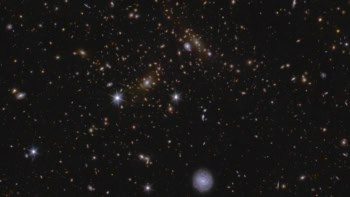Clouds of mercury have been spotted moving across the surface of alpha Andromedae -- a star that astronomers had believed to be too large to support "weather" in its atmosphere. The group, based in Sweden, the US and Canada, have also proposed a new theory suggesting that gravity could be responsible for such weather on large stars, rather than the magnetic fields that shape the surfaces of smaller stars (Nature Physics advance online publication).

Magnetic fields emanating from stars and planets can usually be attributed to convection currents forcing molten metal to shift about in so called “dynamo action”, which converts mechanical energy into magnetic energy. In small stars like our Sun, the magnetic field can become so intense in regions on the surface that it traps heat, causing dark sunspots to form. But physicists believe that most larger stars do not have convection currents stretching to their surface and therefore would have a zero – or at least small – magnetic field. This should mean they are devoid of surface structure.
Recently, however, observations of irregular surface distributions of heavy elements on large blue “B-type” stars have swept aside this assumption. In particular, alpha Andromedae, which is 97 light-years from Earth, has a predicted magnetic field less than 10 Gauss, yet appears to have spots of mercury all over its surface.
Now, a group led by Oleg Kochukhov of Uppsala University has completed a study that traced these spots on alpha Andromedae over a seven year period. They used the Dominion Astrophysical Observatory in Canada and the Spectral Astrophysical Observatory in Russia to record how the strength and shape of the brightest line in the star’s characteristic mercury emission spectrum changed as the star rotated.
To interpret the results, Kochukhov’s group used a clever technique based on the Doppler effect, which makes the wavelength of light appear to compress or stretch depending on how the light is moving relative to an observer. By analysing the mercury line, they could tell whether it had wavelength components coming from parts of the star that were rotating towards or away from the telescopes. In this way, they could build up a detailed picture of how the mercury distribution changed on alpha Andromedae’s surface over time.
“The Doppler imaging technique applied in our investigation is probably the highest resolution remote sensing method astronomers have ever developed,” Kochukhov told Physics Web. “It is equivalent to reading a 1 cm newspaper title from a distance of 350,000 km, which is similar to the distance from the Earth to the Moon.”
The group discovered that the spots were distorted “clouds” that move over the surface of alpha Andromedae in a similar way to clouds on Earth. According to Kochukhov, these could exist because of a delicate balance between the star’s gravity pulling the mercury downwards and the pressure from radiation pushing it upwards. With minor perturbations, the balance would tip, causing regions of higher density mercury to accumulate. Just a 1.3% dip in gravity on the surface, for example, would create 300 times more mercury in that region, says Kochukhov.
Kochukhov thinks that by observing “weather” on stars, we might be able to get a better handle on our own. “[It] provides a new, interesting constraint that contributes to our understanding of how complex systems form,” he added.



